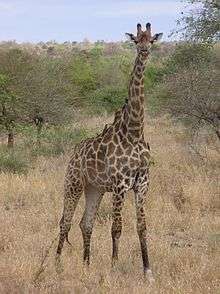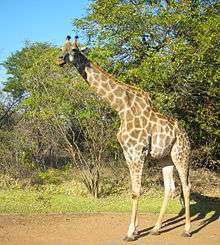Southern giraffe
| Southern giraffe | |
|---|---|
 | |
| A South African giraffe (G. giraffa giraffa). | |
| Scientific classification | |
| Kingdom: | Animalia |
| Phylum: | Chordata |
| Class: | Mammalia |
| Order: | Artiodactyla |
| Family: | Giraffidae |
| Genus: | Giraffa |
| Species: | G. giraffa |
| Binomial name | |
| Giraffa giraffa (von Schreber, 1784) | |
 | |
| Range map in red and tawny-orange | |
The southern giraffe (Giraffa giraffa) is a species of giraffe native to Southern Africa. It ranges from South Africa, Angola, Namibia, Botswana, Zambia, Zimbabwe, Mozambique. It has rounded or blotched spots, some with star-like extensions on a light tan background, running down to the hooves. Once considered a subspecies of the conglomerate Giraffa camelopardalis species, recent studies identified the southern giraffe as a separate species of a reorganised Giraffa genus.[1][2] Their approximate population is composed of 44,500 individuals.[1]
Subspecies
Two subspecies of southern giraffe are recognised.
| Subspecies | Description | Image |
|---|---|---|
| Angolan giraffe (G. g. angolensis), also known as Namibian giraffe | Is found in northern Namibia, south-western Zambia, Botswana, and western Zimbabwe. A 2009 genetic study on this subspecies suggests the northern Namib Desert and Etosha National Park populations form a separate subspecies.[3] This subspecies has large brown blotches with edges that are either somewhat notched or have angular extensions. The spotting pattern extends throughout the legs but not the upper part of the face. The neck and rump patches tend to be fairly small. The subspecies also has a white ear patch.[4]:51 Around 13,000 animals are estimated to remain in the wild; and about 20 are kept in zoos.[1] |  |
| South African giraffe (G. g. giraffa) | Is found in northern South Africa, southern Botswana, southern Zimbabwe, and south-western Mozambique. It has dark, somewhat rounded patches "with some fine projections" on a tawny background colour. The spots extend down the legs and get smaller. The median lump of males is less developed.[4]:52 Approximately 31,500 are estimated to remain in the wild, and around 45 are kept in zoos.[1] |  |
Descriptions
The Cape subspecies of southern giraffe has dark, somewhat rounded patches "with some fine projections" on a tawny background colour. The spots extend down the legs and get smaller. The median lump of males is less developed.[4]:52
Distribution and habitat
The Southern giraffes live in northern South Africa, Angola, southern Botswana, southern Zimbabwe, Zambia and south-western Mozambique. After local extinctions in various places, the South African giraffes have been reintroduced in many parts of Southern Africa, including in Swaziland. They are common in both in and outside of protected areas.[5]
Southern giraffes usually live in savannahs and woodlands where food plants are available. Southern giraffes are herbivorous animals. They feed on leaves, flowers, fruits and shoots of woody plants such as Acacia.
Threats
Southern giraffes are not a threatened species, as their population is increasing.[5] On the other hand, the South African subspecies are occasionally preyed upon by Transvaal lions especially in Kruger National Park.[6] Giraffe calves can also be preyed upon by African leopards, hyenas and Cape wild dogs.
References
- 1 2 3 4 Fennessy J.; Bidon T.; Reuss F.; Kumar V.; Elkan P.; Nilsson M.A.; Vamberger M.; Fritz U.; Janke A. (2016). "Multi-locus Analyses Reveal Four Giraffe Species Instead of One". Current Biology. 26: 1–7. doi:10.1016/j.cub.2016.07.036.
- ↑ Brown, David M.; Brenneman, Rick A.; Koepfli, Klaus-Peter; Pollinger, John P.; Milá, Borja; Georgiadis, Nicholas J.; Louis, Edward E.; Grether, Gregory F.; Jacobs, David K. (2007-01-01). "Extensive population genetic structure in the giraffe". BMC Biology. 5: 57. doi:10.1186/1741-7007-5-57. ISSN 1741-7007. PMC 2254591
 . PMID 18154651.
. PMID 18154651. - ↑ Brenneman, R. A.; Louis, E. E. Jr; Fennessy, J. (2009). "Genetic structure of two populations of the Namibian giraffe, Giraffa camelopardalis angolensis". African Journal of Ecology. 47 (4): 720–28. doi:10.1111/j.1365-2028.2009.01078.x.
- 1 2 3 Seymour, R. (2002) The taxonomic status of the giraffe, Giraffa camelopardalis (L. 1758), PH.D Thesis
- 1 2 Fennessy, J.; Brown, D. (2010). "Giraffa camelopardalis". IUCN Red List of Threatened Species. Version 2012.2. International Union for Conservation of Nature. Retrieved 2013-01-26.
- ↑ Owen-Smith, N.; Mills, M. G. (2008). "Predator-prey size relationships in an African large-mammal food web" (PDF). Journal of Animal Ecology. 77 (1): 173–83. doi:10.1111/j.1365-2656.2007.01314.x. PMID 18177336.